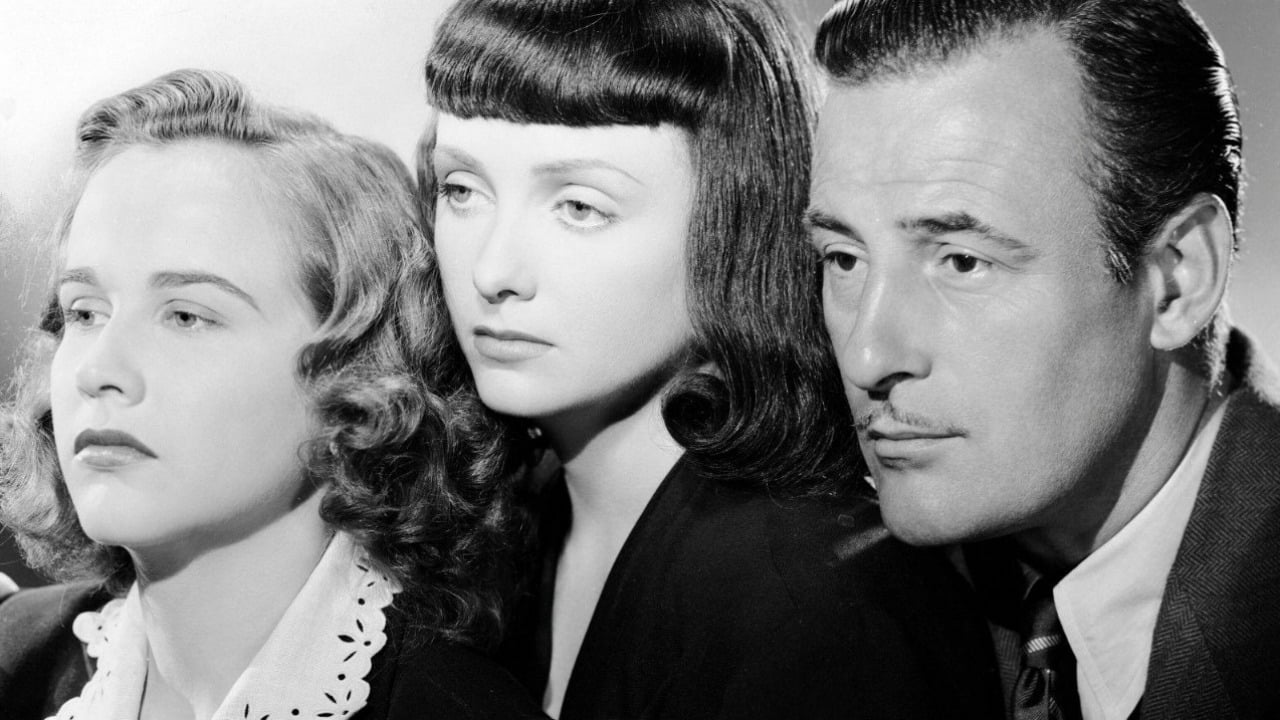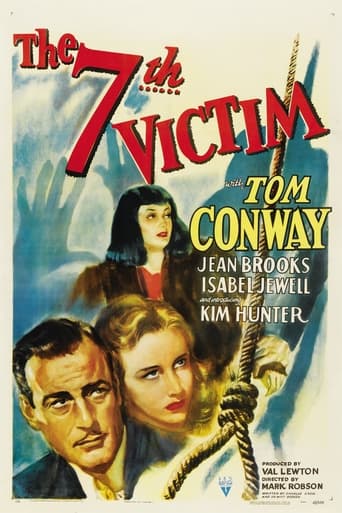Cubussoli
Very very predictable, including the post credit scene !!!
Supelice
Dreadfully Boring
Glucedee
It's hard to see any effort in the film. There's no comedy to speak of, no real drama and, worst of all.
Teddie Blake
The movie turns out to be a little better than the average. Starting from a romantic formula often seen in the cinema, it ends in the most predictable (and somewhat bland) way.
Leofwine_draca
A dark thriller from the popular '40s pairing of director Mark Robson and producer Val Lewton. This relies heavily on atmosphere to unsettle the viewer instead of any visual effects; in fact, there are no special effects at all in this film. There are no monsters, ghouls, ghosts, or spirits. In fact, only two people get killed in the entire thing. Therefore this film might be inaccessible to the latest crazed horror fiend who has been brought up on blood, guts, and more blood. Personally, I found this to be a creepy little low-key thriller.While the Satanic plot may be nothing new, in some ways this film is very different indeed. For instance, the Satanists are depicted as a genteel, tea-drinking group who hate violence, not the typical robed maniacs with huge sacrificial knives. Therefore, the baddies in this film are more chillingly realistic than you might imagine, they could be your fellow workers or neighbours. This was one element of the film I liked. The acting is all above average with the cast giving subtle performances, from a youngish Tom Conway who fits the role of a stern British doctor to a tee through to Isabel Jewell as the surprisingly likable female lead, who gets to be tough and assertive in some scenes, which makes a usual change from the usual role the girl was relegated to in this period - a screaming victim.It's also a plus to have Val Lewton on board, who once again includes much of his own unique visual style. Shadows are used heavily (the very best is made of the black and white) to suggest menace, and it works, making the viewer feeling disquiet and nervous, instead of having in-your-face shock horror, the sort with which we bombarded these days. The strong visual imagery - the horror of the swinging noose - plus the oodles of atmosphere help to lift the plodding plot, which has to be said doesn't really go anywhere. And check out the ending - surprisingly downbeat for the time. THE SEVENTH VICTIM may be difficult to watch for some because it has dated somewhat today, but nonetheless the use of visual artistry is highly effective.
TheRedDeath30
The 1940s were an odd time in the annals of horror history. Of course, this has a lot to do with WWII and the fact that people were facing real horrors in their world, but it was a transitional period as well. Universal's golden age was over. While they were still churning out the movies, they were mostly second rate sequels featuring the same monsters over and over. There was really very little else going on in the horror genre. Film noir and the suspense thriller ruled the box offices and it was no surprise, then, that those genres crept their way into the horror film in the works of Val Lewton at RKO, who took the crown away from Universal and carried it into the next decade, starting with classics like CAT PEOPLE and I WALKED WITH A ZOMBIE. I have always found my personal opinion of Lewton's movies to be lower than those of the horror community, who tend to worship at his feet. By no means am I going to sit here and tell you that these are not great films, but they are not "my style". Further, I would argue that it was Jacques Tourner (as director) who made the early Lewton produced movies so great and once he moved on to other things, RKO was not able to match that early success. But alas, I am getting far too much into my horror geek history lessons and away from the actual movie itself.Our film begins with a young woman who has learned that her sister has disappeared. She leaves school to go to the big city and find her sister. What occurs from there is an odd web of story lines that don't always make a lot of sense. We learn that her sister, Jacqueline, was an odd death-obsessed young woman (goth far before goth was cool). She has just sold her cosmetics empire to her partner. One of the first people that our heroine meets turns out to be her sister's husband. Though married to Jacqueline, he seems to know almost nothing about her personal life, doesn't appear to live with his wife and falls for the young sister in no time, at all. We have poet who hangs around an Italian restaurant. He has stopped writing for a reason that's never truly explains, seems to be the love interest for our heroine, though that story line is cast aside. He joins our other main characters on the quest for a woman he's never met to help some people he just met a few days ago. Now, throw in a psychiatrist, who stopped practicing. He's the only one that knows where Jacqueline is and mainly serves to throw in lines that are supposed to be introspective. We get some odd side characters, as well, such as a private investigator who seems to be here to make one scene work, then disappears just as quickly.Of course, all of this revolves around some devil worshipers. Don't get excited, though. These are not anything close to the cultists you might find in ROSEMARY'S BABY or THE DEVIL RIDES OUT or any of the other late 60s/ early 70s Satanic panic movies. It's basically a bridge club, full of wealthy types, who never actually discuss anything occultist at all, but seem hellbent on preserving their anonymity for some never explained reason.As I'm writing this, I'm actually surprised at the tone that I'm taking because I never intended for this review to bash the movie. In fact, I do enjoy it, but it's occurring to me how silly the plot may be, but that's really beside the point. Like all of the movies produced by Lewton, this movie is all about images, suggestions, fear and shadows. The film carries a pervading fear of death, while at the same time being fascinated by death. Jacqueline (the missing girl) kept a noose in her apartment as a reminder that death was always a step away. An investigator is killed and we learn of many other deaths in the lives of both the occult and our main characters. Death, almost, becomes a character in itself, lurking over the shoulders of everyone involved. None of Lewton's movies were ever really about monsters, or horrors presented cheaply for the audience. Settings and scenarios were created where the audience implanted the horror in their own minds. Some would tell you that this is the best sort of horror. I see this as one of the first examples of something audiences had never even really heard of in 1943, the psychological horror film. This is a movie that's not about monsters in the shadows, or blood on the killer's hand, but about the horrors that lie inside each of our heads and our own innate fears of death.
meddlecore
The Seventh Victim is a nicely shot horror-mystery from RKO. While it's construction is simple, there is a somewhat-complex love pyramid going on, and it has a stylish cult atmosphere.We start off with Mary, as she leaves her girl school existence, in search of her sister- Jacqueline- who has apparently disappeared.She heads into the big city, where she follows a number of leads, with hopes of tracking her sister down. During her search she meets a young poet, a psychiatrist, an old Italian couple, and a few private investigators- one of which has been hired by the husband of Jacqueline, who is secretly in love with Mary.Eventually, with help from one of the PI's (who dies) and the Poet, they manage to track Jacqueline down, as she had been hidden away by the psychiatrist (it is subtly implied they were sleeping together).Jacqueline is, hilariously, goth-as-f*ck. Obsessed with suicide, goth haircut (circa 1940's...impressive!), wears dark furs, shoes and nail polish. Anyways... because she could never find a place to fit in, she inevitably ends up rolling with this secret satanic society that requires a blood oath to join.And they feel that she has broken said oath and must be killed, because she revealed their existence to the shrink (she was probably banging).The poet is secretly in love with Jacqueline, and as such, is working alongside her sister, in order to save her life. But now she's facing accusations of being a murderess, on top of the threats to her life. Though, luckily for her, there are a number of close calls,but she does manage to escape... no thanks to her sister and the poet.Everything with the film goes smoothly, until the final confrontation...during which the whole thing turns into Christian propaganda! I wouldn't be surprised if it originally had a different ending that was considered unacceptable by censors. Basically, the film ends with the notion that the teachings delineated through the Lord's Prayer trump the entire Satanic philosophy and worldview. But this is all summed up in about 3 sentences, so it really comes off as quite humorous...and almost out of place. Totally didn't see that coming.6 out of 10.
Scott LeBrun
It's best not to know too much about the plot before sitting down to watch this interesting and offbeat little film, a nice combination of noir and horror that is written, acted, and directed in style. It's got some marvelously scary and suspenseful moments - especially near the end - and is overall quite the potent meditation on loneliness. It's got a memorable shower sequence that Hitchcock may well have seen and remembered before making "Psycho" 17 years later. Lewton and director Mark Robson (this was the first of the five features that Robson directed for Lewton) do a fine job of keeping our innocent heroine, and the viewer, in the dark for a fair amount of the running time, and create a memorably enigmatic character in Jacqueline Gibson.Kim Hunter debuts as Mary Gibson, a schoolgirl who learns that her sister Jacqueline has gone missing. So she travels to Greenwich Village in search of her, meeting various characters along the way, including lawyer Gregory Ward (Hugh Beaumont), who initially doesn't play it quite straight with her, published poet Jason Hoag (Erford Gage), psychiatrist Louis Judd (Tom Conway), and beauty shop proprietress Mrs. Redi (Mary Newton)."The Seventh Victim" gets very philosophical, and poignant, in the end, with two opposing sides engaging in a rather civil disagreement. But before we get there, there's a very creepy subway ride about which it's best not to reveal too much. Hunter is appealing in the lead. In addition to those actors mentioned, others lending fine support are Isabel Jewell as Frances and the distinctively featured Lou Lubin as concerned private eye Irving August. Jean Brooks as lost soul Jacqueline is excellent once the focus of the story finally shifts to her.Although this entry in Lewtons' filmography underperformed at the box office compared to hits like "Cat People", and wasn't well received at the time, it's very well done and certainly deserving of another look from film fans.Eight out of 10.

